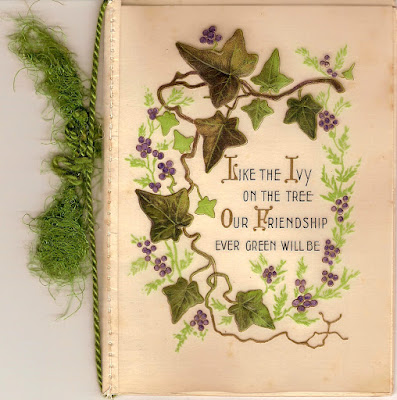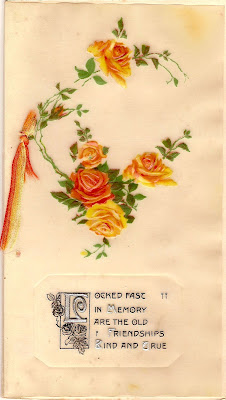 |
Queen Victoria with two family members and attended by her Indian servants
Breakfasting outdoors at Nice in the south of France, 1895. A silver teapot
and china cups sit on the linen covered table. [Source Internet] |
That eternal and confusing puzzle, is "tea" just a drink or a full meal? The exact meaning of "tea", whether just tea and light refreshments or in fact a full meal, varies considerably depending on which part of Britain or parts of the former British Empire you live in or your forbears were from. "Tea" in the north of England, Wales and Scotland typically referred to a full meal, historically taken about 5pm. Were it to be just tea and refreshments that would commonly be referred to as "Morning Tea" or "Afternoon Tea". A light "Supper" of tea with cake or biscuits might be served about 9pm or later.
 |
A Luncheon Menu for Osborne House, the Queen's
residence on the Isle of Wight, 17 Jan 1899
[Source Internet] |
In the south "Tea" would normally refer to Afternoon Tea served anytime between 2pm and 5pm, being a cup of tea with refreshments such as sandwiches, biscuits, or cake. The term "High Tea" referred to a slightly more substantial meal, taken between 5pm and 7pm while "Dinner", a full cooked meal, would normally have been served about 9pm. With the advent of Afternoon Tea in the mid 19th century, "High Tea" at 5pm was slowly replaced with "Dinner", now being served between 7pm and 8.30pm.
 |
Queen Victoria at luncheon with Prince Henry of
Battenburg, Princess Beatrice and their children in
the Oak Room at Windsor Castle, pre 1896.
[Source Internet] |
Anna Maria Russell, Duchess of Bedford, a lifelong friend of Queen Victoria and a Lady of the Bedchamber between 1837 and 1841, was also the originator of "Afternoon Tea". An extra meal called "luncheon" had been created to fill the midday gap between breakfast and dinner, but as this new meal was very light, the long afternoon with no refreshment left the Duchess - and others - feeling hungry. The Duchess found a light refreshment of tea and small cakes or sandwiches counteracted that late afternoon "
sinking feeling" and soon began inviting her friends to join her at Woburn Abbey for this repast. Thus the "ritual" of afternoon tea "
quickly became an established and convivial repast in many middle and upper class households".
 |
A menu for Dinner at Windsor Castle dated
15th May 1879. Such menus are in French
as per the established custom. 32 Diners
including Queen Victoria attended this Dinner
which was to mark the visit of Empress
Augusta of Germany (wife of Emperor
Wilhem I) to Windsor Castle.
[From my personal collection] |
The afternoon tea menu consisted mainly of small cakes, bread and butter sandwiches, assorted sweets, and, of course, tea. The Duchess continued this custom when she returned to her London residence, sending cards to her friends asking them to join her for "tea". The practice of inviting friends to visit for tea in the afternoon was quickly picked up by other social hostesses.
 |
Queen Victoria & Members of the Royal Family Breakfasting in
the Grounds of Osborne House on the Isle of Wight, 1890's.
[Source : Internet] |
Queen Victoria is reported to have quickly taken to this new custom, hosting daily formal dress afternoon tea parties which always ended before 7pm in order to give everyone time to change and be ready for dinner at 9 pm. An oft quoted but quite possibly apocryphal story avowes that "
Queen Victoria, a notorious tea fanatic, was given to flinging her tea cup across the room if she found the tea not up to her standards"!
 |
A Menu for a Dinner at Windsor Castle attended by
The Kaiser, 24th Nov 1899
[Source : Internet] |
Her Granddaughter, Princess Alice The Countess of Athlone, related that Queen Victoria enjoyed almost daily carriage outings in all weathers "
to take the air" including enjoying family picnics. She never minded the weather, often to the chagrin of those accompanying her. Servants accompanying the Royal party would light a fire to boil water for tea which would be served to Queen Victoria while she remained comfortably seated in her carriage.
 |
A Doulton Burslem Bone China Tea Cup & Saucer bearing an
image of Queen Victoria, together with her VR [Victoria Regina]
Cypher and Coat of Arms, 1897 (From my personal collection) |
Due to Queen Victoria's popular connection with tea drinking, there are many examples evident of that royal connection, even today, such as tea blends that she may have favoured to a myriad of period souvenir and commemorative tea cups, saucers and other ephemera connected with tea drinking.
 |
The Dining Room at Osborne House on the Isle of Wight
laid out in the style of a Formal Luncheon or Dinner.
[Source : Internet] |
Queen Victoria's favourite tea is recorded as Earl Grey tea, a China black tea infused with Oil of Bergamot, and served with her favourite shortbread biscuits. Earl Grey tea, taken without milk but accompanied with a slice of lemon, is today particularly favoured by HM Queen Elizabeth II.
 |
An Aynsley Bone China Cup, Saucer & Side Plate Bearing
Queen Victoria's Coat of Arms, together with her Flag
and that of Great Britain, along with an image of the Crown
of State. Produced to commemorate Queen Victoria's
Diamond Jubilee of 60 Years on the Throne, 1897
[From my personal collection] |
"
We are not amused" are the oft quoted words of Queen Victoria. But the Countess of Athlone confirmed of her Grandmother, "
Dear old thing, well she nearly died of laughter". So, while the daily ritual of afternoon tea appears to have wained somewhat in today's busy world, there is still something satisfyingly indulgent and sociable about sitting down to a convivial conversation - or gossip - over a leisurely cup of tea and a slice of cake. Queen Victoria would
definitely approve.
Bibliography :
- Internet resources
- "Life at the Court of Queen Victoria 1861-1901" by Barry St-John Nevill





























